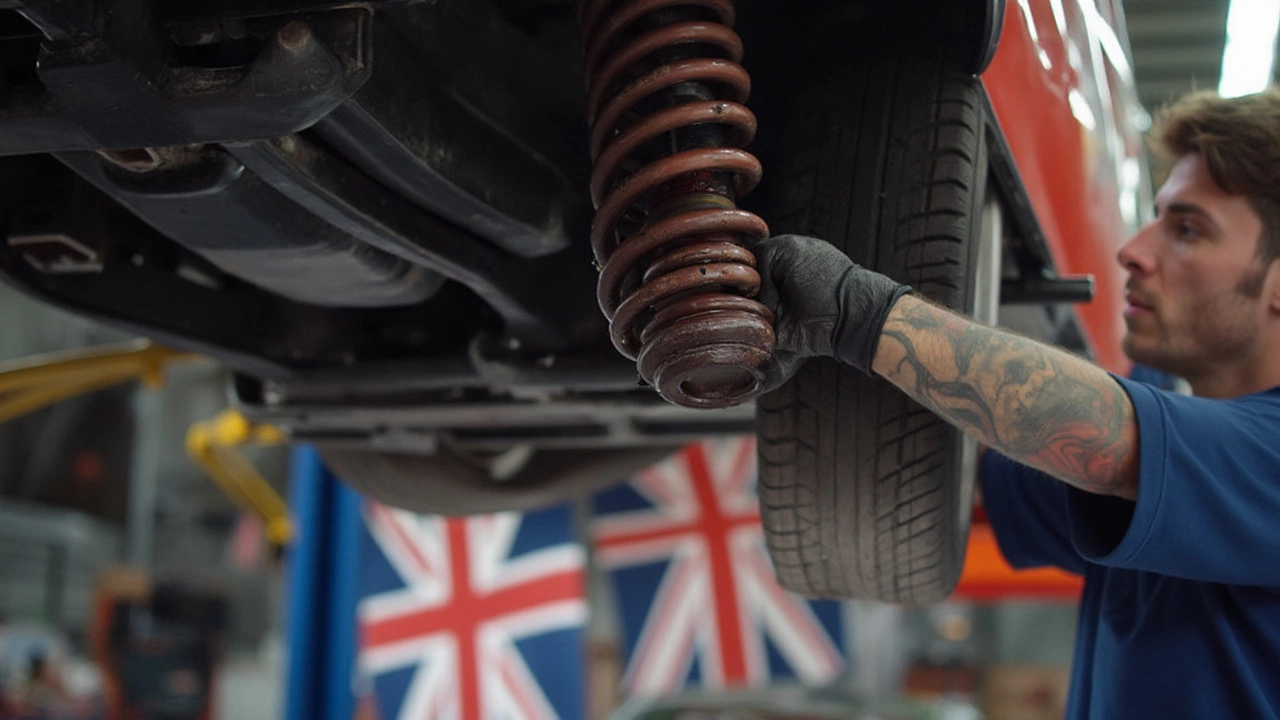So you've been eyeing those sleek lowered cars and wondering if lowering springs could be your ticket to the same visual appeal. But you've also got those stock shocks underneath, and you're not sure if they will play nice with the new setup. The good news? You're not alone in this conundrum.
Lowering springs, for the uninitiated, are designed to drop your car's ride height, giving it a more aggressive stance and often improving handling. But the partnership between lowering springs and stock shocks isn't always a match made in automotive heaven. In some cases, this setup could even lead to a mismatch that impacts ride quality and component longevity.
The key is understanding what you're getting into. By exploring the dynamics of combined setups, you can make an informed decision that keeps your driving experience balanced. We'll dive deeper into how this combo affects your ride, what you should watch out for, and some practical tips to help you along the way.
- Introduction to Lowering Springs and Stock Shocks
- Performance Impact: Pros and Cons
- Longevity and Maintenance Concerns
- Tips for Making the Right Choice
- Alternative Solutions for Better Ride Quality
Introduction to Lowering Springs and Stock Shocks
Dropping your car closer to the ground with lowering springs can do wonders for the looks and handling. These springs replace your standard coils, giving your ride a sportier flair without breaking the bank. But what about the stock shocks? Typically, these shocks accompany the factory suspension setup, designed for a comfortable ride rather than performance.
So, how do lowering springs mesh with stock shocks? It's a bit like wearing sneakers with a tuxedo; it can work, but it's not always ideal. Lowering springs are stiffer and shorter, designed to reduce body roll, improve aerodynamics, and minimize fender gaps. On the other hand, stock shocks are generally longer and softer, tuned for comfort. Combining the two can potentially lead to a harsh or bouncy ride, as the shocks might struggle to keep up with the new springs.
"While lowering springs can improve cornering stability, combining them with stock shocks can lead to premature wear and unpredictable handling," says Alex Howell, an automotive suspension expert.
Questions about compatibility aren't just theoretical. The real concern lies in durability and safety. Stock shocks not designed for shorter springs can wear out quickly, leading to decreased performance or even failure. That's why many enthusiasts opt for aftermarket shocks designed to handle the reduced height and increased stiffness of lowering springs.
Why Consider Lowering Springs?
It's mainly about style and performance. A lowered ride can improve your car's center of gravity, enhancing stability during turns and reducing drag on the highway. Plus, it looks pretty cool, right?
Compatibility Check
Before you jump in, make sure you check compatibility. While some stock shocks may handle mild lowering, more substantial drops often require a combo of lowering springs and performance shocks. Remember, it's not just about how low you go, but how well your car handles at that height.
Just remember, investing in a suspension setup that’s harmonious will pay off in the long run. Even though pairing lowering springs with stock shocks can save money initially, the cost of replacing worn-out shocks can add up quickly.
Performance Impact: Pros and Cons
Getting the right setup for your car is like finding that perfect pizza topping—it has to suit your taste and serve your needs. The same goes for mixing lowering springs with stock shocks. It's important to weigh the ups and downs before making that decision.
Pros of Lowering Springs with Stock Shocks
- Improved Handling: Lowering springs can drop the car closer to the ground, reducing body roll around corners. This can make for better grip and a more responsive drive.
- Affordable Upgrade: If you're not quite ready to invest in a full suspension overhaul, lowering springs are a pocket-friendly way to enhance your car's look and performance.
Cons of Lowering Springs with Stock Shocks
- Poor Ride Quality: Stock shocks are designed for the factory ride height. Pairing them with shorter springs can cause the shocks to 'bottom out,' leading to a jarring ride.
- Reduced Shock Lifespan: Because the stock shocks are compressed beyond their intended range, they might wear out faster. This can lead to another round of replacements sooner than you'd like.
It’s essential to keep in mind your driving style and expectations. If you're someone who takes their car to the track occasionally, the improved handling might be worth it. But if comfort is your priority, this setup might let you down. Whichever way you lean, understanding these pros and cons makes for smarter car modding choices.

Longevity and Maintenance Concerns
If you're thinking about pairing lowering springs with stock shocks, you might wonder if they'll go the distance without causing you a headache. To be honest, factory shocks aren't really designed to handle the extra stress from lowered springs. So, what does this mean for you in the long run?
Wear and Tear: The Real Deal
Your stock shocks could face accelerated wear because they need to work overtime. Imagine running a marathon without training—that's basically what you're asking your shocks to do. Stock shocks are tuned for factory ride height and stiffness, so lowering changes the suspension's geometry, which might reduce their lifespan.
"It's not unusual to see stock shocks giving out sooner after lowering springs have been installed," says Jake Thompson, a seasoned car mechanic with over 20 years in the industry.
Besides the extra workload, another issue can be bottoming out. If the shocks compress too much, it could lead to damage or even failure.
Maintenance Tips to Offset Wear
- Check shocks regularly for signs of oil leakage or abnormal wear.
- Consider having an alignment done after installation to avoid uneven tire wear.
- Be on the lookout for unusual noises, like clunking or squeaking, which could indicate trouble.
For those vigilant enough, a proactive approach could stretch the lifespan of your setup, avoiding potentially costly breakages.
Alternative Solutions
If you're concerned about wear and tear, you might think about investing in performance shocks that are designed to work with lowering springs. They're built to handle different ride heights and offer better durability over time.
Tips for Making the Right Choice
Deciding whether to pair lowering springs with stock shocks isn't a walk in the park. But with shared wisdom and some considerations, you can make the right call for your ride.
Understand Your Driving Needs
First off, think about how you use your car. If you're cruising on smooth city streets, stock shocks with lowering springs might suffice. But if you're into spirited driving or track days, it’s probably wise to invest in performance shocks designed to complement your springs.
Evaluate Your Budget
While lowering springs are an affordable way to enhance your vehicle's look, you might save up for aftermarket shocks too, especially if long-term performance is on your radar. Budget constraints could push you towards a phased upgrade approach—start with springs, then advance to shocks when you're ready.
Consult the Ratings and Reviews
Every car part has feedback. Dive into forums, read reviews, and check community boards. Fellow enthusiasts often share detailed experiences about combining lowering springs with stock shocks, which can be super insightful.
Consider Professional Installation
You might fancy a DIY approach, but suspension tweaks can be tricky. Having a professional handle the installation ensures everything's done right. They can also spot potential issues that a manual and YouTube tutorial might skip over.
Check Vehicle Specs and Limits
Before you jump in, glance at your auto manual. Some car manufacturers provide limits on how low you can go with the stock setup. Sticking within these parameters prevents stressing your vehicle's suspension beyond its intended use.
To sum it up, when it comes to merging lowering springs with stock shocks, it’s all about aligning your goals with practical choices. Dive deeper, weigh your options, and make a decision you're comfy with, both on the street and for your wallet.

Alternative Solutions for Better Ride Quality
If you've been mulling over alternatives to the combination of lowering springs with stock shocks, you're in the right place. This journey is all about finding that sweet spot between style and comfort.
Coilover Kits
Coilover kits are an all-in-one solution that many enthusiasts swear by. They offer adjustable ride heights, so you get that low look without compromising too much on the ride quality. Plus, since these kits include both springs and shocks designed to work together, the performance can be a lot smoother and consistent.
Performance Shock Absorbers
Pairing lowering springs with performance shock absorbers is another popular path. This setup is aimed at those who want improved handling and control. Performance shocks are specifically designed to handle the lower ride height and can offer better dampening than their stock counterparts.
Helper Springs
Helper springs come in handy if you're looking for a slightly lowered look but don't want the full commitment of a lowering spring setup. They work by maintaining the ride height when carrying extra weight, allowing you to enjoy a smoother ride on daily drives.
Air Suspension Systems
If you're after the ultimate in ride comfort and adjustability, then air suspension systems might be your answer. Although more expensive, they let you adjust ride height and firmness with a push of a button, making them a versatile choice for those who want control over their ride quality.
Remember, there's no one-size-fits-all solution here. Consider what matters most to you: the appearance, the comfort, or maybe even a blend of both! By knowing what you want out of your car's suspension, you'll be better prepared to choose the perfect setup for your specific needs.




